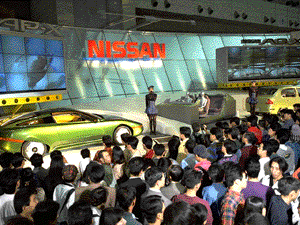 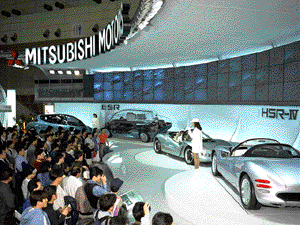
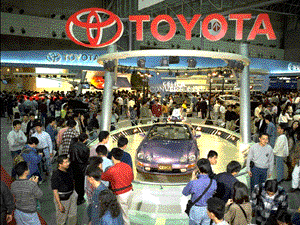
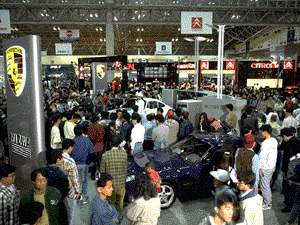

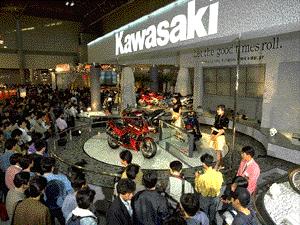
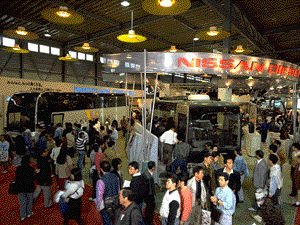
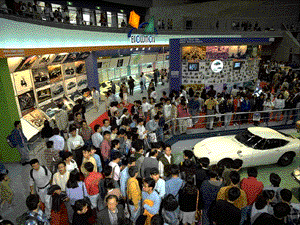
|
"Ecolution in Car Innovation"
The Heisei recession was already in its third year, and recovery was not yet in sight. During this period, the auto industry was tackling restructuring to overcome harsh business conditions such as excessive investment and increased fixed costs, in addition to sluggish auto sales. Restructuring included curtailment of expenditures, reduction of the number of models and parts which had expanded during the bubble days, sharing of parts among models, value analysis (VE), and value engineering (VE),etc. As the situation became more severe, various measures to overcome the recession were taken. They included complementary production of models between companies, cutting off deficit-generating divisions, plant closures, retreat from passenger car production, employment adjustments such as reduction of new hiring and lay-offs. In the midst of these endeavors in 1993, an abrupt appreciation of the yen occurred. The surge of the yen from around ¥120 to as high as ¥100 all at once, offset the restructuring efforts, and deteriorated automakers profitability. In those days, since a rise of one yen caused an exchange loss of ¥35 billion (according to MITI calculations), the auto industry s plight was clear. Meanwhile, 1992 was called "the first year of environment." As a specific measure, fuel consumption for all models was
required to be improved 8.5% over the the 1990 value by 2000. The R & D
investment burden for environment protection, therefore, became even heavier, and the auto industry suffered a structural depression.
In 1993, some bright aspects such as the Crown Prince s marriage and the motor show in autumn were expected to stimulate consumer demand, and offer an opportunity for business recovery. However, political instability (transition from the Liberal Democratic Party to the Hosokawa Government, and difficulties in political reformation) plus an unseasonably cool summer ended in failure for demand creation. Inactivity in other industries further deteriorated the employment situation. The wholly unemployed rate in this year was 2.5%, and the number of jobs offered to those sought dropped to 0.75, from 1.45 during the bubble days (according to the Office of Management and Coordination Agency).Consumer confidence cooled to unprecedented chilly lows. Domestic recession plus weakened international competitiveness due to the higher yen hit the Japanese auto industry severely. Its 1993 exports, totalling 5.02 million units, showed negative growth for 8 consecutive years. Domestic sales of 6.46 million units were down for 3 consecutive years, and total production of 11.22 million units also shrank for 3 consecutive years for the first time since World War II. Production was off 17% from the peak bubble days, which drove automakers into the worst crisis they had ever experienced. As a result, the industry faced a great turning point, and was forced to reform even established vehicles. The 30th Tokyo Motor Show was held amid these abominable circumstances. However, the motor show dared to make suggestions about safety, environment, natural resources, energy, and the relationship between people and vehicles. It was good to see the industry s strong commitment to motivating vehicle development for a new era and coping with the changing times with renewed enthusiasm.
Since this show was held amid a long recession while consumer confidence was low, it attracted attention from many quarters including mass media. Attendance came to 1,810,600, 10% less than the previous show, which was considered a good showing given the adverse conditions. In fact, there were still 300,000 more visitors than the 1.52 million who attended the 16th Show at Harumi at the peak of the Harumi days. This seemed to indicate enhanced interest in the shows, based on the spread of vehicular society.
The next-generation concept cars and reference exhibits at the Motor Show reflected advancements in the Japanese auto industry. Visits by many top executives, engineers and designers from overseas suggested that it had become difficult to precisely forecast vehicle trends or assess the world auto industry s balance of power without seeing the Tokyo Motor Show. One of this show s characteristics was the hightened international position of the Tokyo Motor Show. In fact, participants included 352 companies, 4 governments and one organization representing 15 countries, yet another record. The world s major automobile producing countries joined the show. In addition, 10,794 domestic and foreign media people gathered at the show on press days to report the directions in which the changing auto industry was heading (an increase of 22.2 % over the previous show). These included 9,025 Japanese (up 25.7 %) and 1,769 foreign (up 7.0 %), both all-time highs. Of note this year were the many journalists who came from China, Taiwan, Korea and other Asian countries. This seemed to indicate that the Tokyo Motor Show, while being vehicle festival, was also regarded by the world as an information base to speed the arrival of a new age.
The exhibition of 264 reference cars, one third of the total exhibits,
attracted the world s attention. They looked gorgeous enough to blow the recession away. Domestic automakers exhibited 209, of the 264. exceeding the foreign makers 55. Almost all of the 209 next-generation concept cars were the products of endeavors to boost safety and protect the environment. They were much closer to practical applications, than those at the previous show, a sign of great progress.
|